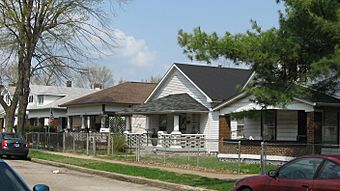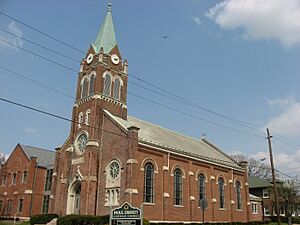Haughville, Indianapolis facts for kids
Quick facts for kids |
|
|
Haughville Historic District
|
|

Houses on Warman Avenue
|
|
| Location | Indianapolis, Indiana |
|---|---|
| Area | 67 acres (27 ha) |
| Architect | Bedell, George |
| Architectural style | Late Victorian, Romanesque |
| NRHP reference No. | 92001652 |
| Added to NRHP | December 9, 1992 |
Haughville is a historic neighborhood located west of downtown Indianapolis. It's bordered by White River Parkway, Tibbs Avenue, 16th Street, and Michigan Street. This area began in the 1830s and grew after a bridge was built over the White River. This bridge connected Haughville to Indianapolis, which later became part of the city in 1897.
Today, the bridge still links Haughville to important places like the Sidney & Lois Eskenazi Hospital and Indiana University - Purdue University Indianapolis. In the late 1890s, many immigrants from Europe, including Slovenia, Germany, and Ireland, made Haughville their home.
Contents
Exploring Haughville's Past
A special part of Haughville is known as the Haughville Historic District. This area is listed on the National Register of Historic Places. It includes many historic buildings that show what the neighborhood was like long ago.
Early Settlement and Growth
Haughville was first settled in the 1830s. Small shops appeared near the Washington Street Bridge over the White River. By the 1880s, more people moved here because of the bridge and new railroad lines.
Many Irish, German, and later Slovene immigrants came to Haughville. They often worked in the neighborhood's iron foundries or meat-packing plants. The Haugh and Ketcham Iron Works gave the town its name. Haughville became an official town in 1883 and joined Indianapolis in 1897.
Slovenian Community and Heritage
By 1900, nearly half of Haughville's residents were Slovene. Many attended St. Anthony's Catholic Church. Later, the Slovenian community built their own church, Holy Trinity Slovenian Catholic Church, which opened in 1906.
Holy Trinity is the only Slovenian Catholic church in the United States. It is also an important historical landmark. It became a center for the Slovenian community, with a school and local organizations. The church closed in 2015. Indianapolis has a sister-city relationship with Piran, Slovenia, partly because of Haughville's Slovenian history.
The Slovenian National Home, often called "the Nash," was started in 1906. It was a place for Slovenian people to gather outside of church. Since 1940, the Nash has been a key part of the community at 2717 W. 10th Street. It is a private club for Slovenian people, their families, and friends.
Haughville Historic District Details
The Haughville Historic District was added to the National Register of Historic Places in 1992. The important historical period for this district is from 1895 to 1942. This shows the time when the neighborhood grew and changed significantly.
People of Haughville
In 2011, about 8,043 people lived in the broader Near Westside area, which includes Haughville. The population of Haughville itself is estimated to be around 6,500 people. Most of the residents are African-American. There is also a mix of White and a growing Hispanic population.
Learning in Haughville
Haughville is home to a public library. This library is the oldest branch of the Indianapolis Public Library that has been open continuously. It provides a great resource for learning and reading in the community.
Famous People from Haughville
- Wes Montgomery, a very famous jazz guitarist, grew up in Haughville.





